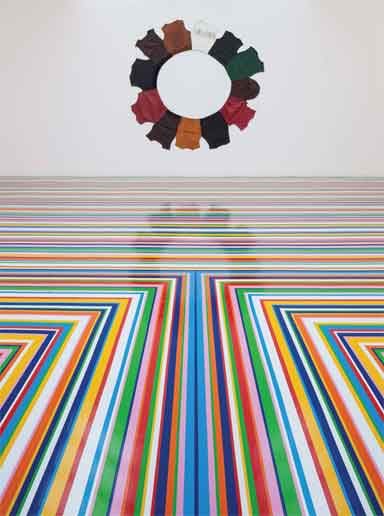|
DESCRIBED as a selected retrospective of work made from 1996 to the present day, The Fruitmarket Gallery's exhibition presents the art of the internationally renowned artist Jim Lambie.
Glaswegian Lambie, who came to prominence in the late 1990s, was a member of the band The Boy Hairdressers. After his departure to study art they went on to become the highly successful Teenage Fanclub. As well as this Lambie has been a dj for many years so his work is firmly rooted in music and youth culture.
The exhibition is fairly sparse for a retrospective, however, Lambie's trademark piece Zobop (1999-2014) makes up for this as it entirely covers half the stairway and upper floor of the gallery. It is composed of what is thought of as humble material, that is, multi-coloured vinyl tape. The effect is one of a tripped-out Bridget Riley Op-Art painting, psychedelic, dizzying even.

Jim Lambie, The Fruitmarket Gallery 2014, Ruth Clark
Before encountering Zobop, the ground floor gallery consists of two pieces, Shaved Ice (2012-14) and a DVD entitled Ultraflow (2007). Shaved Ice is like a forest of brightly coloured ladders in the palette of the DIY store, some are fluorescent and there is still a slight whiff of paint.
The ladders are mirrored between the rungs (and there are a lot of them); this creates a disorientating, kaleidoscopic effect, which is fun and disconcerting at the same time.
|
However, disconcerting as it may be, Shaved Ice is nothing compared to the DVD Ultraflow and the dangerously dark room in which it is shown (complete with warning). It was noticeable that people were entering and then leaving almost immediately.
This room is very dark, the DVD glows dimly in the distance with pinpoints of light, the lit ends of cigarettes, circulating and hovering in the darkness. The space between the viewer and the screen has the allure of a no-go area yet, weirdly, it resembles a dance floor. The experience is akin to one of being in a dark nightclub wearing dark glasses whilst slightly drunk.
As mentioned, Zobop takes over the upper gallery, which is no bad thing; it gives off a feeling of exuberance and creates a backdrop for the artwork.
Now the viewer is in Zobop world and what they find is a teenage bedroom of dreams circa the mid to late 1970's. For example, a wall of mirrors taken from old dressing tables by the look of them, entitled Perm and Blow Dry (2001), and a wall decorated with the backs of twelve leather jackets which form a circular shape, Digital (1999).
This is echoed in Two Shirts (1996) which, as the name suggests, are two shirts covered in duct tape, one silver and one black, these have been folded and mounted on the wall.
At this point a Saturday Night Fever pitch is starting to materialise. A poster of the disco group Earth, Wind, and Fire helps this along; it has been customised with black paint and hung upside down. Then there is Roadie (1999) a black, glittery record deck with rotating turntable, underneath hangs an array of multicoloured clothes hangers.
Stakka (2000), a floor installation/sculpture of customised vinyl record sleeves adds to the teenage bedroom idea. However, this is not an environment stuck in time. Instead, it comes across as absolutely part of now, the turntable keeps on turning and Lambie is keen to evoke a feeling of perpetual motion.
The idea that it conveys is one of the continuations of culture, that is, even though certain music, clothes and artefacts belong to a past era, they are the building blocks on which the culture of the present and future is based.
At the age of 50 Lambie is showing that when it comes to the particular culture you align with age is irrelevant. A new piece entitled Bluebird (2014) suggests that the ethos apparent in the earlier pieces is still alive and well. A pair of men's black leather Ecco shoes are joined together by a chain of safety pins, one is stuck to the ceiling, the other hovers a few feet from the floor.
There is a collage on the sole of the lower shoe, which shows images of the group The New York Dolls and Lou Reed (the so called god-father of punk).
The connotation of striding out in Ecco shoes (perhaps for the more mature man) with images of icons from another era on the sole delivers a succinct message. It says, our culture lives on well past our youth; we carry it with us on the soles of our shoes.
CATH BELL
JIM LAMBIE EXHIBITION - THE FRUITMARKET GALLERY UNTIL OCTOBER 19
|